|

A Different Rendition
Puccini's 'Tosca' on the big screen,
reviewed by MARIA NOCKIN
The furor over the Met's new Tosca whetted the curiosity of Arizona opera fans. Thus, theatres were full long before the performance began at ten o'clock on the morning of Saturday 10 October 2009. Live opera movie-goers are a hardy bunch, and there were no more good seats to be had by half past nine. On the screen there was a warning about the possibility of sunspot problems over the United States, but luckily nothing of that nature interrupted the transmission. Many viewers were not happy with the darkness of the entire production, but were told that the dimly lit stage was the choice of Swiss theatre, opera and film director Luc Bondy.
Bondy has staged opera with notable success in several of the world's great opera houses, but when he took his bow after the Met's opening night on 21 September 2009, the reception in the auditorium was not completely positive. No one really knows the opinions of the five thousand viewers who saw the performance on the screens in Lincoln Center and Times Square. By the time of the October high definition transmission, however, some changes had been made and the folks from Phoenix and its suburbs were very pleased with the show. In the first act, Bondy included several actions that most likely would not have occurred in a church in nineteenth century Rome, such as having Scarpia kiss the lips of a statue of the Madonna. It is also doubtful that Tosca would have brought flowers to cast on the church floor. In the second act, Bondy omitted the soprano's traditional placement of a crucifix and candles around the body of Scarpia, but his staging almost never contradicted the actual sung text.
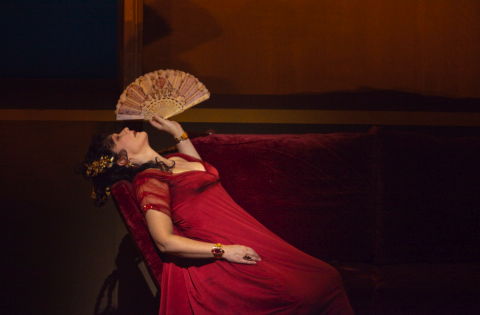
Karita Mattila in the title role of Puccini's 'Tosca' at the New York Metropolitan Opera. Photo © 2009 Ken Howard
|
Even movie opera is, in the long run, about singing, and this Tosca had excellent vocalists who created detailed life-like characters as they sang. Finnish soprano Karita Mattila was a quirky, impossibly jealous diva who could not withstand the baron's intense psychological pressure. In church with Cavaradossi she sang sweetly, but her voice developed some steel when she faced Scarpia and his torturers in the second act. She is not only a fine singer but a magnificent actress as well. As her lover, Argentine tenor Marcelo Alvarez seemed a tiny bit nervous at the very beginning, but once he got into his first aria, Recondita Armonia, his legato began to flow smoothly. From that point on, he portrayed the rebellious Italian painter with beauty of tone and excellent control.
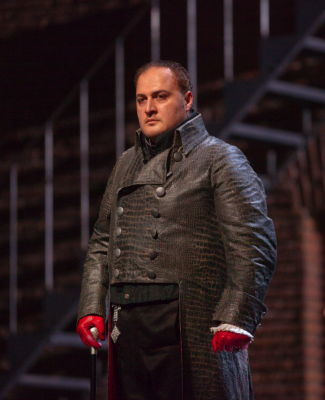
George Gagnidze as Scarpia in 'Tosca' at the New York Metropolitan Opera. Photo © 2009 Ken Howard
|
Craftily setting the lovers against each other was the murderous Baron Scarpia, played brilliantly by Georgian baritone George Gagnidze. A new face to many, he seemed to embody the evil of high level government corruption. Scarpia could kill anyone who opposed him with total impunity and his lust was equally unbridled. Although Tosca said they would meet before God, it is doubtful that it worried this consummate villain.
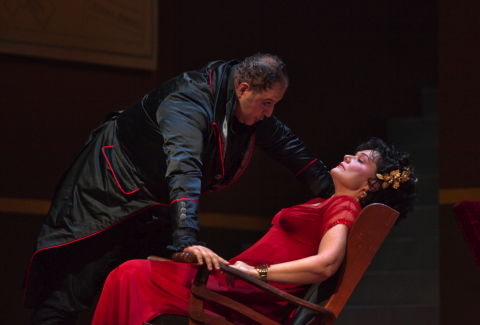
George Gagnidze as Scarpia and Karita Mattila in the title role of Puccini's 'Tosca'. Photo © 2009 Ken Howard
|
While Alvarez sang with glinting bronze tones, it was Mattila and Gagnidze who created the opera's mesmerizing drama. One could not help weeping with her when she asked why her good deeds were repaid with cruelty. When she stabbed her attacker, not once but twice, her audience completely understood her motivation and seemed ready to urge her on. Gagnidze is a wonderfully evil Scarpia and it will be interesting to see more of his interpretations.
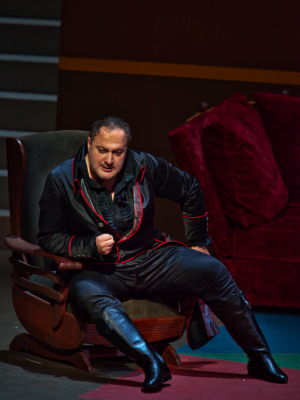
George Gagnidze as Scarpia. Photo © 2009 Ken Howard
|
In Act III, Alvarez sang his impassioned aria of farewell to a dark sky, but listening to that voice one doubted if anyone cared. His sound was all enveloping. When Mattila appeared a few moments later, she seemed a bit tired and one of her high notes was noticeably flat. Other than that, she sang extremely well for the entire performance and pleased the audience that had already fallen in love with her during the first act.
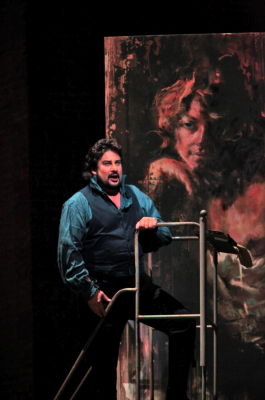
Marcelo Alvarez as Cavaradossi. Photo © 2009 Ken Howard
|
Bondy effected a coup de théâtre when he had Tosca push the leading soldier back down the steps so that she was free to jump from the tower above. Actually, she runs inside the tower and a puppet is seen falling from a window. It worked well and the opera ended with a clever bit of theatre magic.
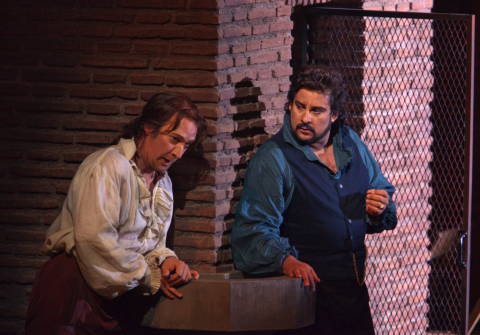
David Pittsinger as Angelotti and Marcelo Alvarez as Cavaradossi. Photo © 2009 Ken Howard
|
Several other artists added immeasurably to the drama. Bass Paul Plishka, was an officious and amusing Sacristan. Angelotti's character was brought to life by the clear sounds and realistic acting of bass David Pittsinger. Tenor Joel Sorenson and bass-baritone James Courtney were thoroughly frightening as Scarpia's leading henchmen.
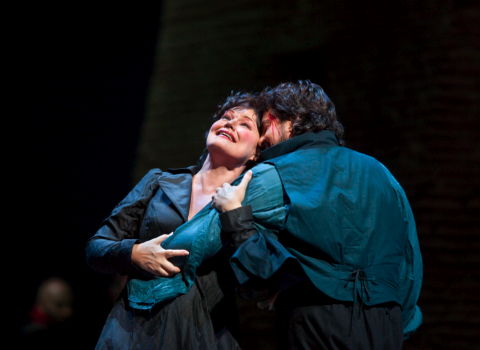
Marcelo Alvarez as Cavaradossi and Karita Mattila as Tosca. Photo © 2009 Ken Howard
|
This was a different rendition of Puccini's Tosca, but it was so well sung and acted that it will be remembered for ages by the huge audience that saw it not only in the opera house but also in movie theaters located in forty countries around the world.
Copyright © 18 October 2009
Maria Nockin,
Arizona USA

| 
